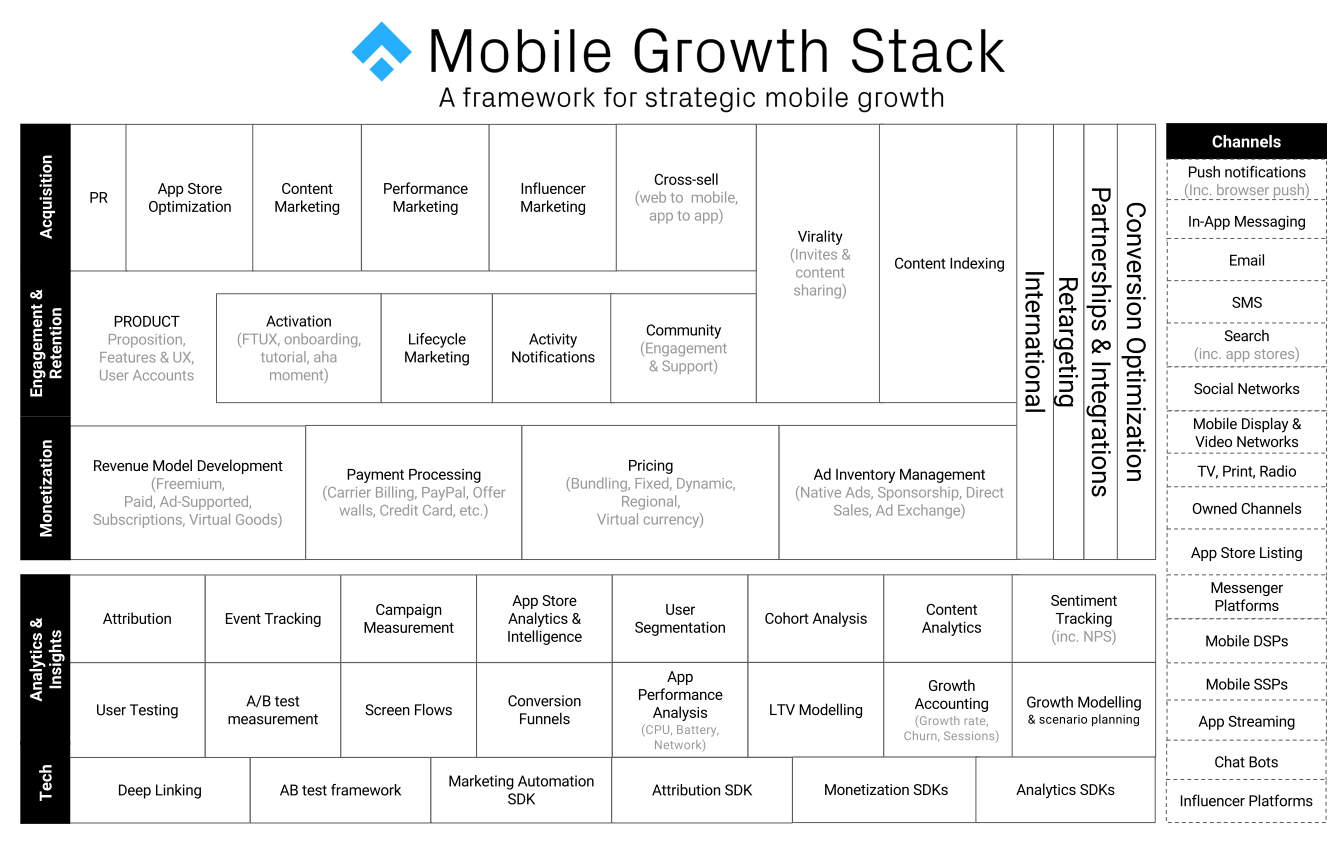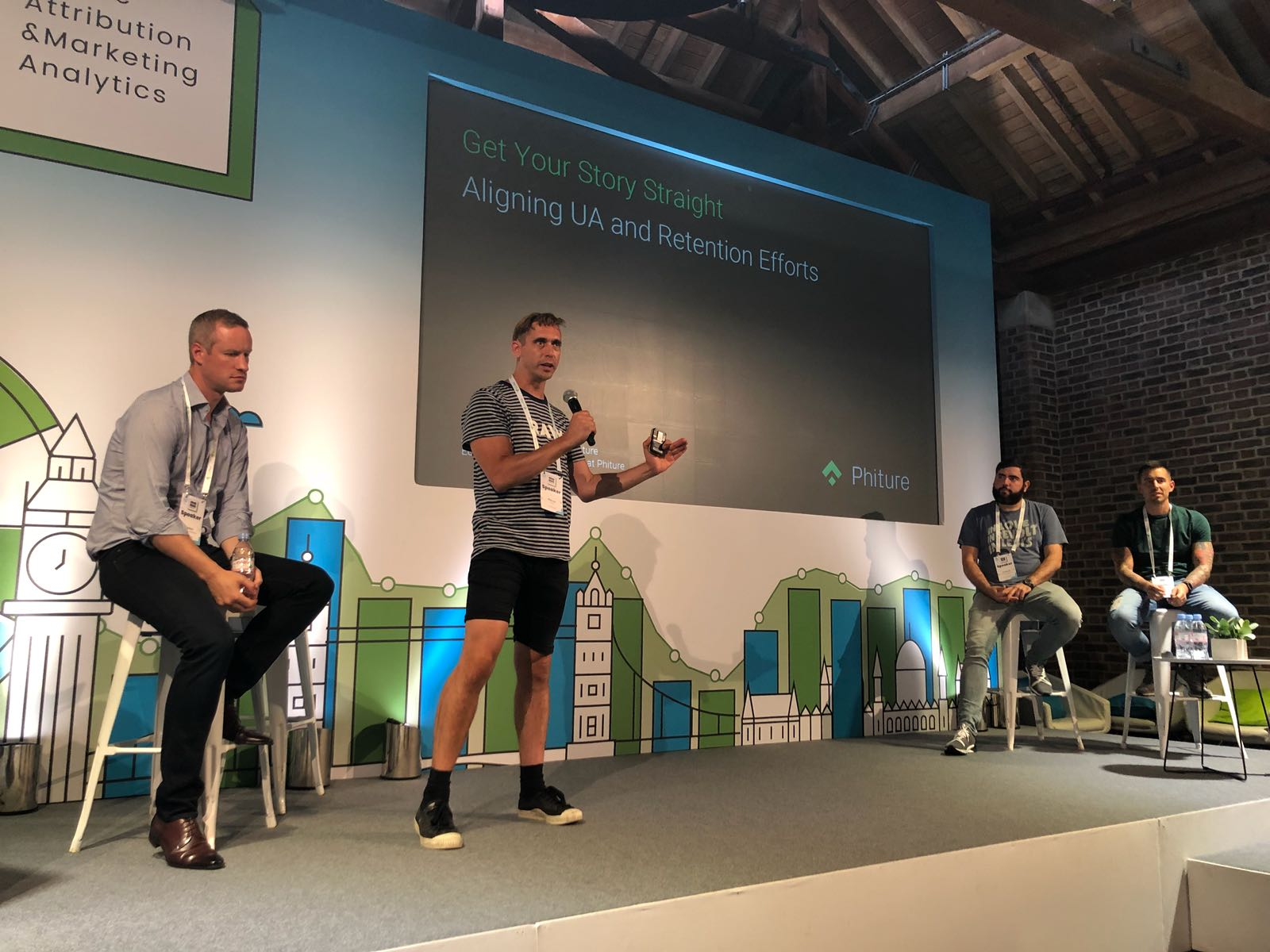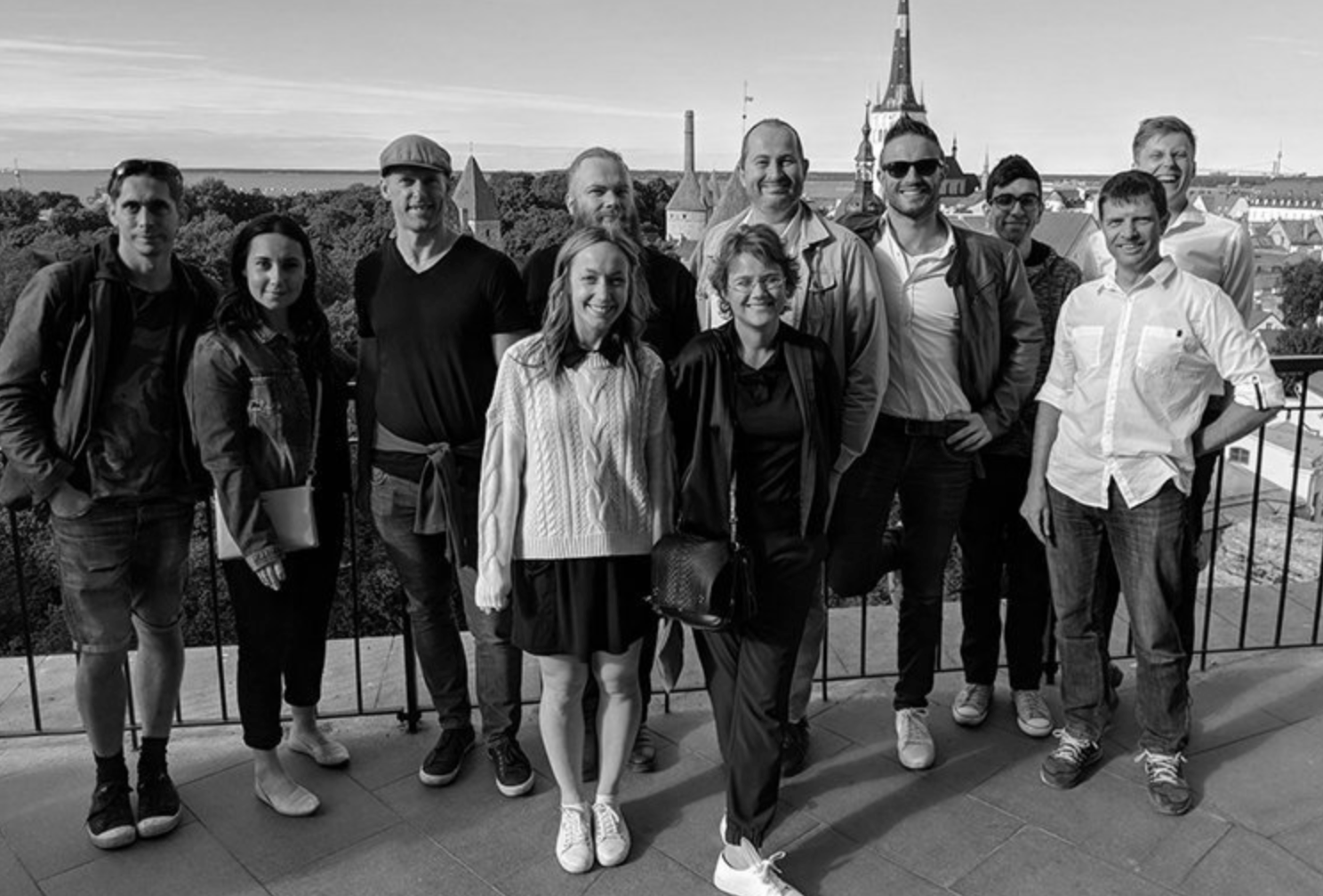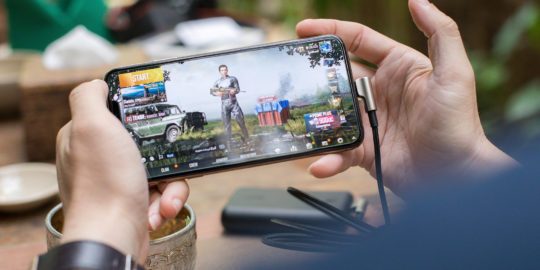Andy Carvell is the co-founder of Phiture, a Berlin-based mobile growth consultancy. He started his career as a game developer at Nokia in 1999 (when Snake was the only mobile game on the market), and now has over 19 years of experience working in the mobile industry.
Between 2012 and 2016, Andy led several data-driven growth teams at Soundcloud. It was there that he developed The Mobile Growth Stack, a framework that helps marketers and growth professionals develop strategies for growing the user base of mobile products.
The Mobile Growth Stack has been popularized through the Phiture blog as well as Andy’s speaking engagements at events like Digital Elite Camp Estonia 2018, Appsflyer MAMA, Mobile Apps Unlocked, and App Growth Summit.
With all his expertise and years of experience in mobile, we were eager to catch up with Andy about the famous Mobile Growth Stack, brands killin’ it on mobile right now, how all-star mobile growth teams conduct experiments, and more.
How did you become interested in the mobile industry and what was the inspiration behind the business model of your company?
I’ve been in mobile since the early days of the industry. My first job out of university was with Nokia in 1999, where I joined the team as a game developer. Mobile phones weren’t ubiquitous back then, and the only mobile game was Snake on the Nokia phone. It was there that I got super excited about the concept of a mobile computer that’s connected to the world. Since then, I’ve worked in many different areas, but mobile has been the common theme throughout my career.
About the business model behind my company now — Phiture is a mobile growth consultancy and agency. My team and I wanted to see if we could effectively systemize the key areas of mobile growth and build repeatable processes applicable across app verticals. We also wanted to figure out methods and frameworks to solve problems pertaining to growth, such as app store optimization, retention and engagement, and CRM. It’s been working really well so far!
You created a Mobile Growth Stack framework that incorporates major updates and trends in mobile growth. Explain the framework and its key components.
The Mobile Growth Stack came about when I was working at Soundcloud, where I was growing adoption and usage of the Soundcloud mobile app. It is the result of trying to identify key drivers of mobile growth, and turned out as a one-page cheat sheet for mobile marketers and mobile growth professionals. It’s essentially a grid with various activities and channels that are relevant to developing a mobile growth strategy.
The Stack is organized into three layers — acquisition, retention and engagement, and monetization. These layers are universal business objectives for mobile apps. They are supported by an analytics layer, which is the foundation of the Mobile Growth Stack. After all, if you don’t have analytics, you can’t measurably improve your activities in the rest of the layers.
The one thing that people sometimes misunderstand about the Mobile Growth Stack is its complexity. They get overwhelmed by the details and think they have to do everything. But that’s not what the Stack is about. It’s trying to encapsulate at least 90 percent of the things you could do, so you can then pick and choose what is most likely to drive success.
In one of your articles, you state that influencer marketing is beginning to augment — and even replace — traditional mobile app install campaigns. Why is this, and how do you make influencer marketing part of an app’s growth strategy?
Replace is a strong word, but influencers can definitely augment acquisition campaigns. In some cases, it’s becoming an extremely effective channel for acquiring high-quality users at a low cost — something that wasn’t available until just a few years ago.
There is nothing new about influencers. Brands have been sponsoring celebrities for a long time. What has evolved is the ecosystem. There are now diverse sets of influencers catering to every single niche, including on interesting digital-first and mobile-first channels that apps can take advantage of.
Influencer marketing is also democratizing. In the past, brands had to go through agents or agencies to reach influencers. Now they can get in touch with influencers directly.
When it comes executing a success influencer campaign, it’s important to understand your ideal user, so you can identify influencers whose audience fits the bill. You then need to work closely together to craft content that will appeal to this audience. There is a great blog post on Phiture that further elaborates on what constitutes a smart influencer strategy.
How do successful mobile growth teams around the world conduct growth experiments?
It always starts with measurement, which is why analytics and insights are the foundational layer of the Mobile Growth Stack. If you’re not measuring impact, then it’s not an experiment, nor is it scientific. Going with that, experiments need to be hypothesis-driven. The quality of a hypotheses will often be a big factor in the overall quality of an experiment.
I’m a big proponent of pairing qualitative analysis along with quantitative data. I spoke with the growth team at Airbnb, and they pair a call researcher with a quantitative analyst. I think that’s really smart. Too often, companies that want to consider themselves data-driven turn their nose up at qualitative analysis — they think it’s not as reliable or scientific as quantitative data. But when the two come together, you can derive better results. So, use quantitative data to see what is going on, and throw in qualitative data to explain why it is happening.
[bctt tweet=”Use quantitative data to see what is going on, and throw in qualitative data to explain why it is happening. — @andy_carvell” username=”leanplum”]
It is also important to celebrate failure when running experiments. If you expect every experiment to be a win, you’re going to be very disheartened. A true experiment either proves or disproves a hypothesis. If it’s a failure, you’ve learned something — what not to do and why it failed. That should be rewarding. It means you can move on to the next thing, which might be a success. And you’ll be better informed for future experiments.
At Leanplum, we talk a lot about the role of app notifications in mobile marketing. What makes a sophisticated notification strategy?
Great notifications always start with some type of trigger — something has changed that the user would be interested in. It could be a calendar or time-based event, or maybe new content arrived on a platform (this was a big one for Soundcloud — people wanted to be notified when an artist they followed released new tracks, albums, or playlists).
A good notification comes from understanding who your users are and what they’re going to be genuinely interested in. You want to make them feel grateful for receiving information they might have missed out on otherwise. You want them to feel excited about opening your push notification or email.
[bctt tweet=”A good notification comes from understanding who your users are and what they’re going to be genuinely interested in. — @andy_carvell” username=”leanplum”]
A sophisticated notification strategy recognizes different types of users. Not just that you have 1MM active users and 2MM dormant users. There are different reasons why users are active or dormant. Some users might be casual users, some might be power users. Oftentimes, they have different personas, and have varying motivations for using your app.
The better you understand the diversity of your users, the better you can segment, target, and personalize your notification strategy. With this knowledge, you can even tailor the cadence of your notifications. The ultimate goal is to personalize down to an individual level. But even if you can only personalize down to some core segments with different psychological profiles, that’s a pretty good start.
In your opinion, what brands are absolutely killin’ it on mobile right now? What can be learned from them?
Number 26, or N26, a German mobile-first banking app, is impressive. About a year ago, I opened an N26 bank account. You have to go through a video registration process — showing your ID and whatnot to a person through a camera — but everything is done through mobile.
What I really like is that the app sends notifications whenever you spend any money. I had a situation where I checked out of a hotel and was mistakenly charged a deposit fee, and the app sent me a notification right away. This enabled me to deal with the issue right at the counter, rather than when my bank statement arrived at the end of the month.
Getting that instant feedback made me feel really connected to my bank account. Plus, N26 is truly built from the ground up for mobile. I think they’re killin’ it.
Lifecycle marketing is a big topic in mobile right now. How can brands map out an ideal user journey to execute an impactful lifecycle marketing program?
A common theme in my answers is that it all starts with understanding your users deeply. This means actually talking to them and conducting research on a regular basis to gauge how they feel, think, and what they are doing. If you have a good grasp of these factors at each stage of the lifecycle, then you can start to think about what might help them along that journey.
You can even ask “what would make this easier?” directly in user testing to make mapping out that ideal user journey straightforward. All users are different. There are additional optimizations to be made by adapting your approach based on these variations. There is no one size fits all solution.
The speakers from Digital Elite Camp 2018 in Estonia
In the mobile industry, a lot of emphasis is placed on acquiring as many new users as possible. Unfortunately, this often leads to cheap, low-quality installs and no lasting retention. How do apps overcome this challenge and attract users that actually stick around?
This is, of course, the golden question. If that was an easy, simple answer then everyone would have super successful apps. Retention is really tough — that’s why at Phiture we’re focused on building services and processes that really help companies improve these metrics.
I think, first of all, that you have to approach it from both ends — product market fit involves iteration on both product AND marketing (positioning, targeting, etc.). And it’s not a binary thing… it’s an ongoing process.
Something that a lot of companies aren’t doing well is aligning marketing and product teams so that what is promised in marketing is actually delivered on the product end. Ideally, this needs to be optimized in a user’s very first session, because people churn very quickly on mobile if value isn’t delivered immediately.
[bctt tweet=”Align marketing and product teams so that what is promised in marketing is actually delivered on the product end. — @andy_carvell” username=”leanplum”]
I’m also writing a series of blog posts on this topic, detailing the Retention Audit program we developed at Phiture and how we go about helping companies with retention and engagement using a CRM-centric approach leveraging push, in-app and email channels.
A question we ask all our Mobile Trailblazers: What’s one thing you’d like to optimize about your life?
I’m always trying to optimize my MEDS: Meditation, Exercise, Diet, and Sleep. I am really poor at building consistent healthy habits around these things, even though I think they are very important pillars in a balanced, healthy life. It’s a constant struggle for me to work on these consistently and evenly, and I tend to flit between them and optimize one or two, to the detriment of the others.
—
For more great interviews in our Mobile Trailblazers series, read our conversations with Sujan Patel, Peggy Ann Salz, Bo Ren, and SC Moatti.









